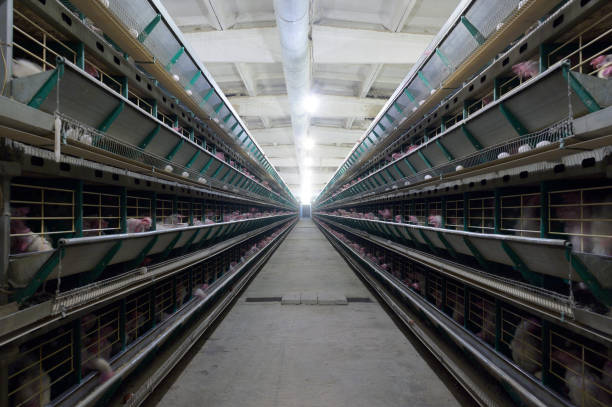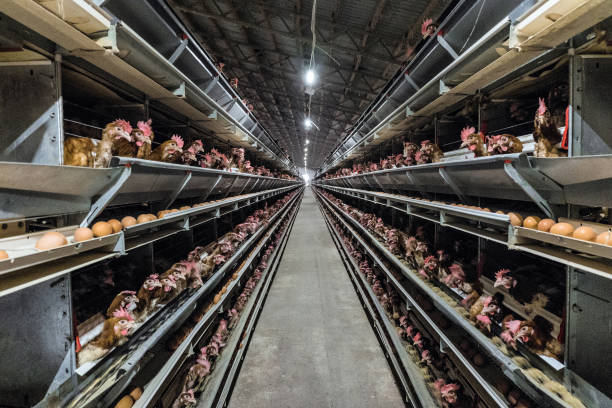Setting Up a Large-Scale Poultry Farm in Nigeria: A Comprehensive Guide
Setting Up a Large-Scale Poultry Farm in Nigeria: A Comprehensive Guide
Nigeria, with its burgeoning population and increasing demand for protein, presents a lucrative opportunity for poultry farming. However, establishing a large-scale operation demands careful planning, strategic investments, and a thorough understanding of the local market. This comprehensive guide, tailored specifically for the Nigerian context, will walk you through the essential steps, from initial feasibility studies to sustainable management practices, ensuring your poultry farm thrives.
**I. Laying the Foundation: Market Research and Feasibility Study**
Before diving into the practical aspects, conducting thorough market research is paramount. This involves understanding the current demand for poultry products (eggs and meat), identifying your target market (consumers, hotels, restaurants, institutions), analyzing competitor activities, and assessing price trends.
* **Demand Analysis:** Determine the specific poultry products in demand. Is there a higher preference for broiler meat, layer eggs, or both? What are the preferred sizes and qualities?
* **Target Market Identification:** Pinpoint your primary customer base. Are you aiming for individual consumers, wholesale markets, or specific industries? Understanding their needs and preferences is crucial.
* **Competitive Landscape:** Analyze existing poultry farms in your region. Identify their strengths and weaknesses, pricing strategies, and distribution channels. This will help you differentiate your farm and gain a competitive edge.
* **Price Trends:** Track historical and current market prices for poultry products to forecast future price fluctuations. This will inform your pricing strategy and ensure profitability.

The feasibility study builds upon the market research data, evaluating the economic viability of your project. It involves a comprehensive assessment of the following:
* **Projected Revenue:** Estimate your potential income based on projected production levels, market prices, and sales channels.
* **Production Costs:** Calculate all expenses associated with establishing and operating the farm, including land acquisition, construction, equipment, feed, labor, utilities, and veterinary services.
* **Profitability Analysis:** Project your profit margins, return on investment (ROI), and payback period. This will help you determine the financial feasibility of the project and attract potential investors.
* **Risk Assessment:** Identify potential challenges, such as disease outbreaks, market volatility, and rising feed costs. Develop mitigation strategies to minimize these risks.
**II. Secure Land and Design Your Farm Layout**
Choosing the right location is critical to the success of your poultry farm. Consider the following factors:

* **Accessibility:** Ensure the farm is easily accessible via good roads to facilitate transportation of feed, supplies, and finished products.
* **Water Availability:** Poultry require a reliable and abundant source of clean water. Consider drilling a borehole if necessary.
* **Electricity Supply:** A stable electricity supply is essential for lighting, ventilation, and other farm operations. Explore alternative energy sources like solar power to reduce reliance on the national grid.
* **Environmental Regulations:** Ensure the location complies with local environmental regulations regarding waste disposal and noise pollution.
* **Proximity to Markets:** Ideally, the farm should be located relatively close to your target markets to minimize transportation costs and spoilage.
* **Land Size:** The size of the land should be sufficient to accommodate your planned poultry houses, feed storage facilities, processing area (if applicable), and employee housing.
A well-designed farm layout is essential for efficient operations and biosecurity. Consider the following:
* **Poultry House Design:** Choose a design that provides adequate ventilation, natural light, and temperature control. Open-sided houses are common in Nigeria, but consider climate-controlled houses for better performance and disease prevention, especially in warmer regions.
* **Cage Systems vs. Deep Litter:** Decide whether to use cage systems (for layers or broilers) or deep litter systems. Cage systems generally offer better space utilization, hygiene, and egg collection efficiency. Deep litter systems can be more cost-effective initially but require more labor and careful management to prevent disease. Consider the Livi Machinery egg-laying chicken cages and broiler chicken cages for optimized space and easy management.
* **Feed Storage:** Construct a secure and weatherproof feed storage facility to protect feed from spoilage and pest infestations.
* **Waste Management:** Implement a proper waste management system to dispose of manure and other waste materials in an environmentally friendly manner. Consider composting or using manure as fertilizer.
* **Biosecurity Measures:** Design the farm layout to minimize the risk of disease introduction and spread. Implement measures such as perimeter fencing, foot dips, and restricted access to poultry houses.
**III. Investing in Quality Equipment and Infrastructure**
Investing in quality equipment and infrastructure is essential for efficient and productive poultry farming.
* **Poultry Houses:** Construct durable and well-ventilated poultry houses using appropriate materials.
* **Cage Systems/Deep Litter Equipment:** Install cage systems (like Livi Machinery’s offerings) or deep litter equipment, depending on your chosen farming method.
* **Feeding and Watering Systems:** Invest in automated feeding and watering systems to ensure consistent and efficient delivery of feed and water to the birds. Nipple drinkers are recommended for hygiene.
* **Ventilation System:** Install fans and other ventilation equipment to maintain optimal air quality and temperature inside the poultry houses.
* **Lighting System:** Provide adequate lighting to stimulate egg production in layers and promote growth in broilers. Consider using energy-efficient LED lights.
* **Egg Collection System:** Install an automated egg collection system (for layer farms) to reduce labor costs and minimize egg breakage.
* **Waste Management Equipment:** Purchase equipment for collecting, handling, and disposing of poultry manure, such as manure spreaders or composting equipment.
* **Scales and Weighing Equipment:** Use scales to accurately weigh feed, birds, and eggs to monitor performance and identify potential problems.
* **Biosecurity Equipment:** Invest in foot dips, disinfectant sprayers, and other biosecurity equipment.
**IV. Choosing the Right Breed and Sourcing Quality Chicks**
Selecting the right breed is crucial for maximizing productivity and profitability.
* **Broiler Breeds:** Popular broiler breeds in Nigeria include Cobb 500, Ross 308, and Arbor Acres. These breeds are known for their rapid growth rate, high feed conversion efficiency, and good meat yield.
* **Layer Breeds:** Common layer breeds include Isa Brown, Bovans Brown, and Lohmann Brown. These breeds are known for their high egg production, good egg size, and disease resistance.
* **Dual-Purpose Breeds:** Consider dual-purpose breeds if you want to produce both meat and eggs, although their performance in either category may not be as high as specialized breeds.
Source day-old chicks from reputable hatcheries that guarantee the quality and health of their chicks. Ask for vaccination records and ensure the chicks are properly vaccinated against common poultry diseases.
**V. Implementing a Sound Feeding Program**
Feed accounts for a significant portion of the total production cost, so it is crucial to implement a sound feeding program.
* **Formulated Feeds:** Use commercially formulated feeds that are specifically designed for broilers or layers at different stages of growth. These feeds contain the necessary nutrients for optimal performance.
* **Feeding Schedule:** Follow a strict feeding schedule and provide the birds with the right amount of feed at the right time.
* **Feed Quality Control:** Regularly monitor the quality of the feed and ensure it is free from contaminants.
* **Water Quality:** Provide clean and fresh water at all times. Water is essential for digestion, nutrient absorption, and overall health.
**VI. Maintaining Strict Biosecurity Measures**
Biosecurity is critical for preventing disease outbreaks and protecting your investment.
* **Restricted Access:** Limit access to the poultry houses to authorized personnel only.
* **Foot Dips:** Place foot dips containing disinfectant at the entrance of each poultry house.
* **Protective Clothing:** Require all personnel entering the poultry houses to wear protective clothing, such as overalls and boots.
* **Regular Cleaning and Disinfection:** Regularly clean and disinfect the poultry houses and equipment.
* **Vaccination Program:** Implement a comprehensive vaccination program to protect against common poultry diseases.
* **Disease Monitoring:** Monitor the birds closely for any signs of disease and consult with a veterinarian immediately if any problems are detected.
* **Rodent and Pest Control:** Implement a rodent and pest control program to prevent infestations.
**VII. Staffing and Training**
Hire competent and experienced personnel to manage the farm. Provide adequate training on all aspects of poultry farming, including feeding, watering, disease prevention, and biosecurity.
**VIII. Marketing and Sales Strategies**
Develop a comprehensive marketing and sales strategy to promote your products and reach your target market.
* **Direct Sales:** Sell directly to consumers through farm shops or local markets.
* **Wholesale Markets:** Supply to wholesale markets and retailers.
* **Contracts:** Secure contracts with hotels, restaurants, and institutions.
* **Online Marketing:** Utilize online platforms to promote your products and reach a wider audience.
**IX. Sustainable Management Practices**
Implement sustainable management practices to minimize the environmental impact of your farm.
* **Waste Management:** Dispose of manure and other waste materials in an environmentally friendly manner.
* **Water Conservation:** Implement water conservation measures to reduce water consumption.
* **Energy Efficiency:** Utilize energy-efficient equipment and practices to reduce energy consumption.
**X. Financial Management and Record Keeping**
Maintain accurate records of all income and expenses to monitor the financial performance of the farm. Use financial statements to track profitability and make informed business decisions.
**XI. Legal and Regulatory Compliance**
Ensure that your farm complies with all relevant legal and regulatory requirements, including environmental regulations, labor laws, and food safety standards. Obtain all necessary permits and licenses.
**Conclusion:**
Setting up a large-scale poultry farm in Nigeria requires significant investment, careful planning, and diligent execution. By following this comprehensive guide, conducting thorough research, investing in quality equipment (like Livi Machinery’s cage systems), and implementing sound management practices, you can increase your chances of success in this thriving sector. Remember to stay informed about the latest developments in poultry farming and adapt your strategies as needed to remain competitive in the dynamic Nigerian market. Good luck!





